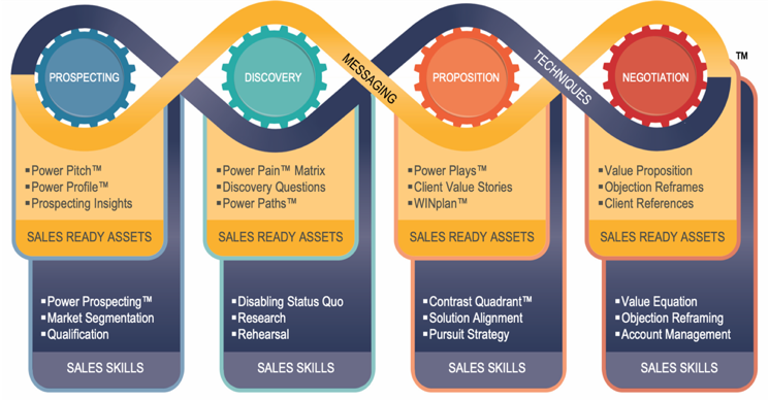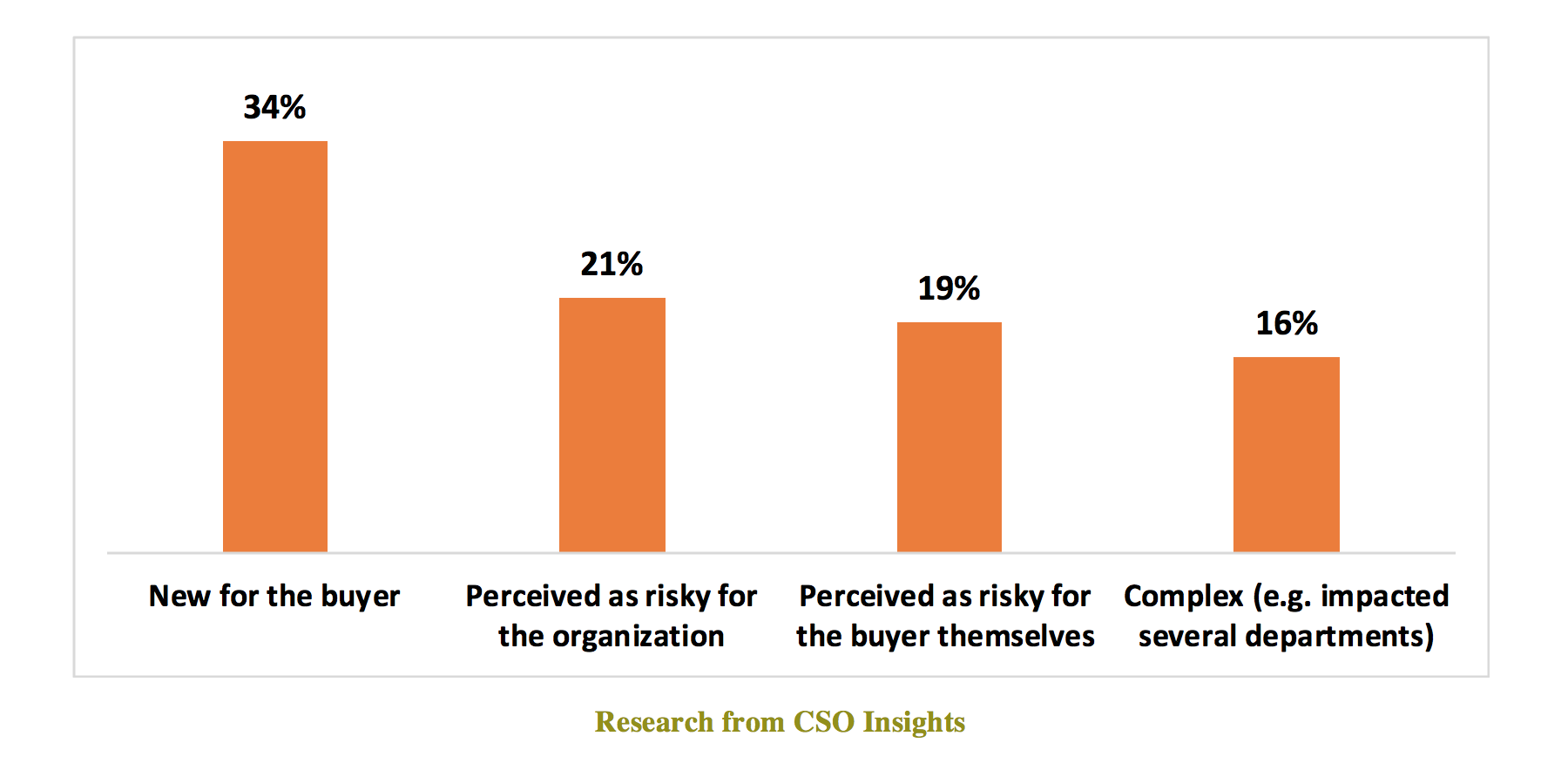
A history of sales enablement — and predictions for its future
Travel back to 1999, perhaps in a cubicle-lined office or around a rectangular conference table, John Aiello and Drew Larsen strategized a new approach to sales operations and management.
What were they fighting against? Decades of:
- Misaligned and inconsistent differentiated value messaging.
- Lack of buyer and solution information.
- Ineffective and nonexistent sales processes.
These issues had been infiltrating the sales world and obliterating salespeople’s effectiveness at doing their jobs — to sell. And these problems were plagues across industry, geography and selling organization size.
Add that to a changing B2B buyer, where the buyer had begun to shift from a reliance on salespeople for information to seeking it out themselves through new technological advancements.
Aiello and Larsen pioneered a method to improve the efficiency and effectiveness of salespeople that was catered toward the changing buyer. They preached new selling strategies and consistent selling strategies. The pair spoke to learning customer pains and committing to relevant conversations full of value. They promoted alignment across the organization.
Some people caught on and began implementing their sales enablement strategy right away, however, the majority did not catch-on until the 2010s. The increased interest drove new technology solutions, which then drove data analysis and research firms to get on board to better help salespeople lead with value in their interactions with buyers. Sales enablement-specific positions exist at the majority of sales organizations (60% according to CSO Insights study). In fact, Gartner estimates 15% of technology spending in 2021 will be invested in sales enablement technology.
Today, sales enablement is an organizational best practice. While its popularity has held strong for the last decade, many organizations still struggle with the core ideologies of sales enablement. The good news is that sales enablement is in the reach of every selling organization.
The Future of Sales Enablement
Sales enablement expert Tamara Schenk nails the definition of sales enablement:
The Sales Enablement Society, or SES, defines sales enablement as follows:
What is the common theme in these two definitions? It is about the client and the professionals that engage with them. Make those people more effective at serving the client and everyone wins – especially the client! That’s Seek to Serve.
This structure will continue to drive sales enablement into the future, but let us explore a few key elements of these definitions that will shape and evolve and mature as sales enablement moves forward and becomes even more widespread in the B2B industry.
COLLABORATION
Sales enablement is a tag-team effort. Client-facing professionals – namely “sales” – are the real target for enablement by the rest of the business. And let’s be clear that means sales reps but also front-line sales managers. Marketing, product and operational teams have a responsibility to arm and equip sellers, which is an effort that necessitates engaging sales in a dialogue about what is needed and then working together oftentimes in active coordination to create valuable selling assets.
These efforts can center around product launches, merger and acquisition assimilation, scaling the sales system and more. It takes a village — or in this case, an organization — working together with a common purpose of predictable sales results.
Historically, there has been “water-cooler” talk between the sales team and their sales support brethren. But going forward, the sales support teams must be even more intentional about engaging sales. In-person workshops will likely transform in the future to incorporate at least some virtual characteristics as teams come together to create what sales needs. In many ways this virtual future can actually accelerate the process — as the organization is not as constrained by travel to support in-person meetings.
SERVICES
Sales is the consumer of which services exactly? These are not so straightforward and not always tangible:
- Skills
- Content
- Tools
Each of these services must be architected around the conversations between buyers and sellers along the buyer journey and sales process continuum in order for the exchange of true value.

As the first half of 2020 turned our organizational practices on its head, virtual tools have been rapidly adopted and widespread. Use these to digitize the delivery of skills training through eLearning — not just in classroom instruction but also virtual role-plays. Our friends at Commercial Tribe offer solutions to enable your leadership to create effective and robust digital trainings to connect with their sales teams and make an impact.
Additionally, explore digitizing the delivery of sales content and tools, empowering sellers with the access to and knowledge of how to pair the right tool with the right message at the right time for the buyer journey. Content and sales assets must be predicated on a value messaging framework that is compelling for buyers by first addressing their pains—while accentuating solution differentiation for competitive advantage. Membrain, Mediafly and Klyck all offer sales enablement technology that can empower your organization to do just that; Mereo principals have witnessed these tools action with many clients to great effect.
Finally, with an increased investment in sales enablement technology, sales support teams will gain a better view of current gaps, what other tools are needed, how and when assets are being used, and how to improve content strategy and development into the future.
ADDING VALUE
Seek to serve is the prevailing theme that drives Mereo and that we seek to impart on the Firm’s clients. Why? Because it works regardless of industry trend or market situation. Every customer interaction provides a forum for creating more value for your audiences. As you press forward, how can you add that value differently or more meaningfully?

The answer is simple but hard to follow through on: Know more about the customer than they know about themselves. Buyer empowerment is only growing as digital spaces widen and journeys are side-stepping salespeople later and later. When buyers do engage, your salespeople need to deliver insights to these conversations — or risk losing. What those conversations look like matters. Customers do not want to hear about products or even solutions. With sellers they want to garner leading practices on the marketplaces, to gain a better understanding of their risk factors and to simplify the complex.
Seek to Serve, Not to Sell™ is the true north star of selling — here and now but also into the indefinite future of sales enablement.

By Jay Mitchell
Jay Mitchell is an accomplished entrepreneur and sales and marketing thought leader, who has invested the past 20+ years unleashing the revenue performance of market leaders worldwide including Ariba, Pitney Bowes, Accel-KKR, Ace Hardware, SuccessFactors, Miller Heiman, AlixPartners, SAP, and many more.
He has served in a variety of roles during his career including President, CEO, CMO, board member, and investor to over 150 innovative champions. As Mereo’s founder and president, Jay brings a passion for helping companies align their marketing and sales infrastructure. With a heart for serving clients, Jay's others-focused values are inspiring to his clients and peers alike – as reflected in Mereo’s purpose: Seek to Serve, Not to Sell™. Jay, a proud Baylor Bear, currently resides in Austin, TX with his family.
Find out more about Jay Mitchell on LinkedIn







